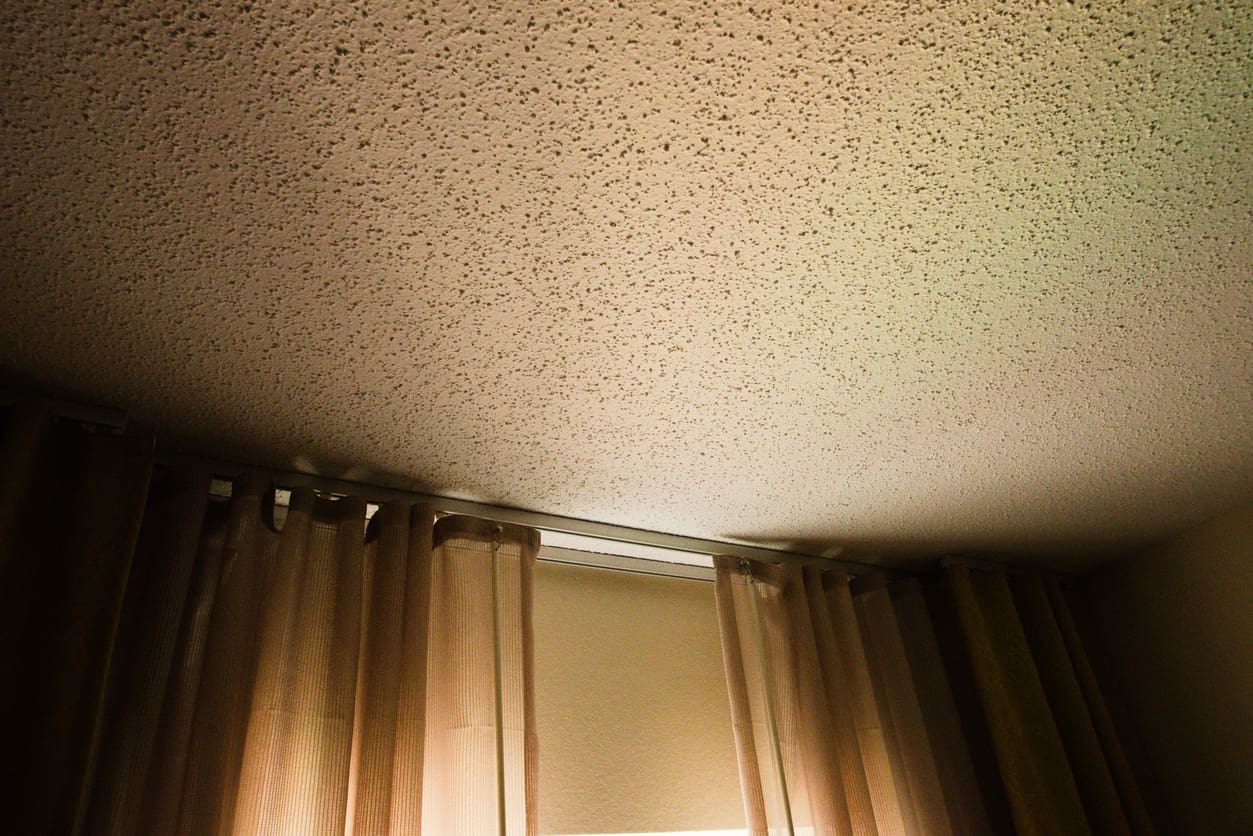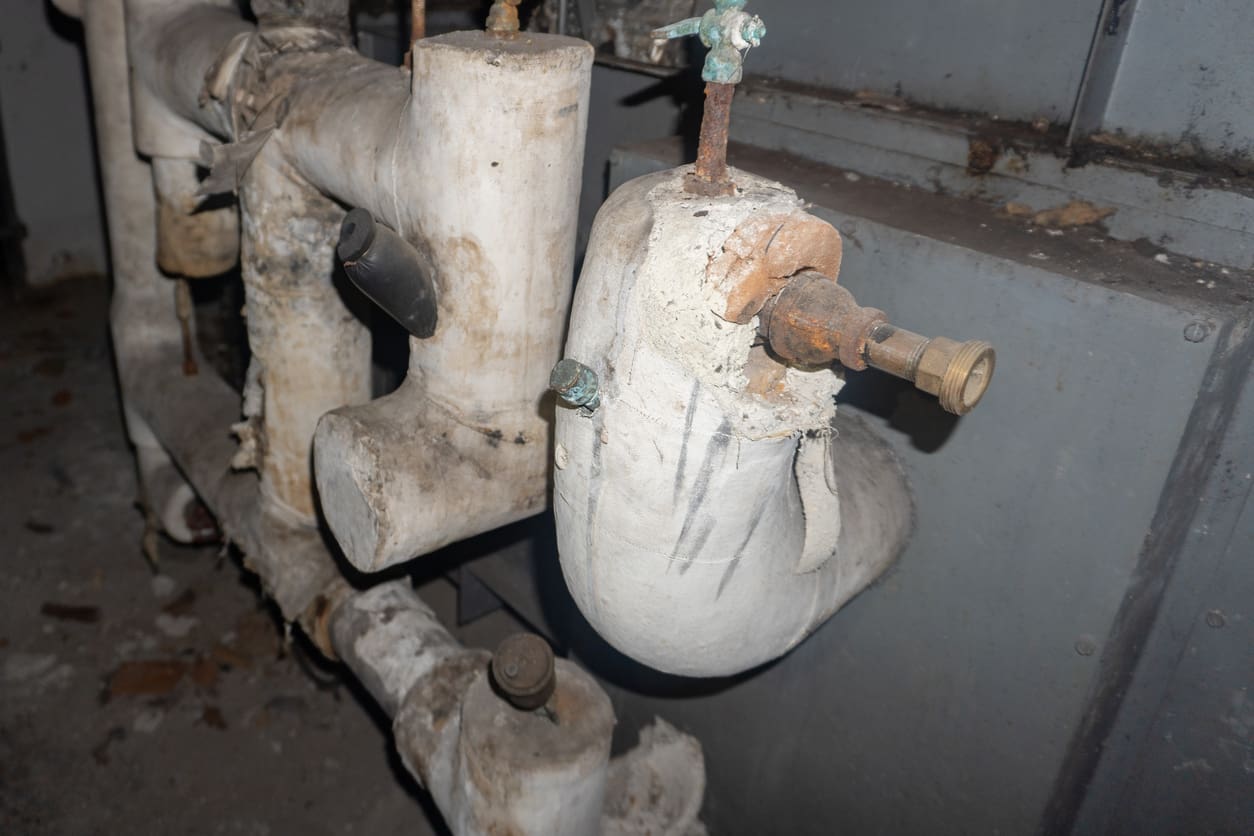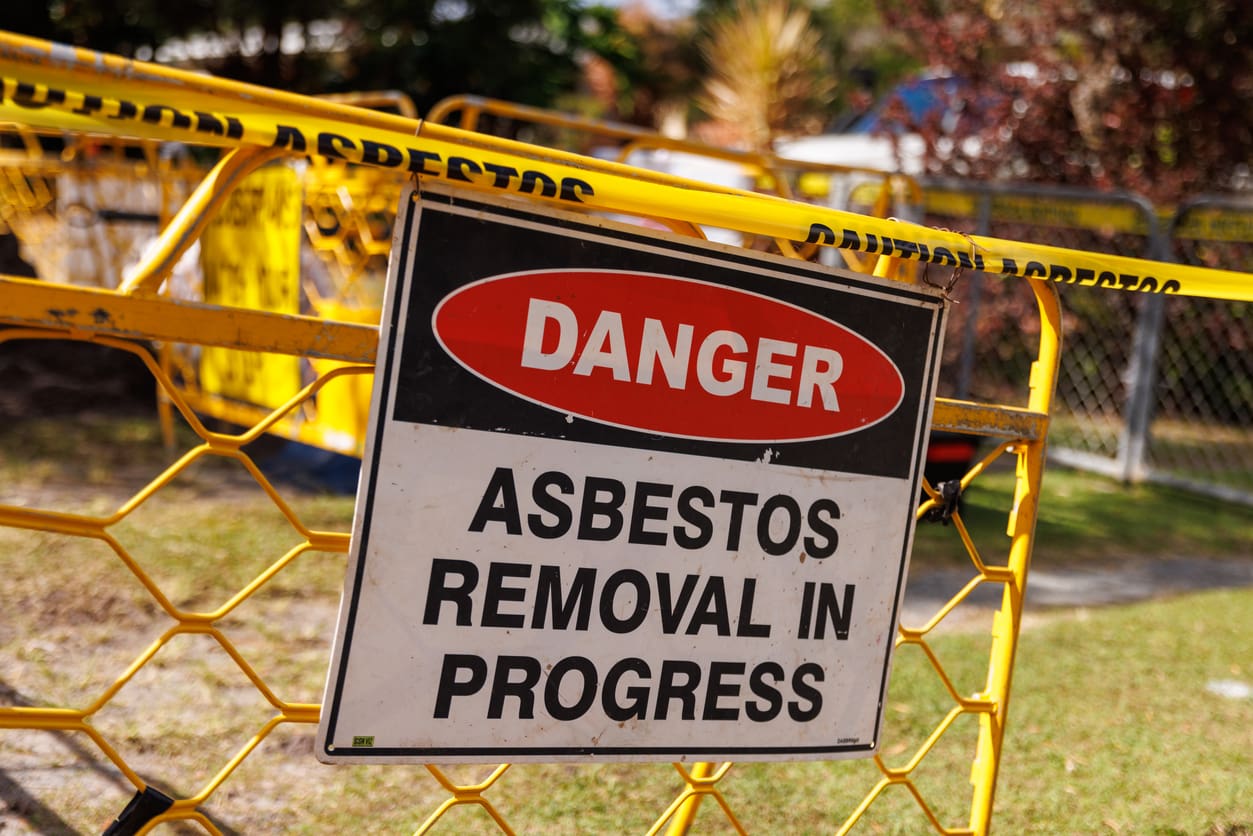Asbestos was once a standard building material, praised for its fire resistance and durability. Historical asbestos use was widespread in construction, especially in insulation, roofing, and flooring. This extensive asbestos use led to serious health risks, such as asbestosis and mesothelioma, which ultimately resulted in bans and strict regulations. If you own an older home, you may wonder how to identify asbestos in your home and what to do if you find it. In this guide, we’ll cover the key signs of asbestos, the potential health risks, and the safest next steps for homeowners.
Introduction to Asbestos
Asbestos is a naturally occurring mineral fiber once a staple in the construction industry due to its impressive durability, fire resistance, and affordability. It was commonly added to building materials such as insulation, flooring, and roofing for decades to enhance their strength and fire protection. However, it is now well established that asbestos exposure can lead to severe health problems. When asbestos-containing materials are disturbed, tiny asbestos fibers can become airborne and easily inhaled, where they may lodge in the lungs. Over time, this exposure can cause serious diseases, including lung cancer, asbestosis (a chronic lung condition), and mesothelioma, a rare but aggressive cancer. Because the health effects of asbestos may not appear for many years, it is crucial for homeowners to be aware of the risks and to identify any asbestos-containing materials in their homes. Proper handling and management are essential to prevent the release of asbestos fibers into the air and to protect your family’s health.
How to Identify Asbestos in Home: Common Locations

Asbestos was widely used in construction before the 1980s, and it can still be found in several areas of the home. Insulation is one of the most common locations for asbestos, particularly in attics, walls, and around pipes. Many construction materials containing asbestos, including cement sheets, drywall, roofing shingles, ceiling and floor tile, and asbestos cement products, historically used asbestos for its fiber strength and heat resistance. Many older homes also contain asbestos in their flooring, especially in vinyl tiles and linoleum backing. Ceiling tiles and textured paint often included asbestos to enhance durability and fire resistance.
Additionally, roofing and siding materials manufactured before the regulations changed may still contain asbestos. HVAC ducts, heating ducts, and pipe wrappings in older homes could also be sources of asbestos, as it was frequently used for heat insulation and fireproofing. Identifying these materials can be difficult, as asbestos fibers are often mixed with other substances. After mentioning insulation in attics, it's important to note that vermiculite insulation may also be present and can be contaminated with asbestos.
Many homeowners may not realize their home contains asbestos because it has no distinct smell or appearance. It is often mixed with other materials, making it difficult to detect without specialized testing. Asbestos is usually invisible to the naked eye and may require professional assessment to identify. Some asbestos-containing materials may remain intact and pose little risk if left undisturbed. However, aging and environmental factors can cause degradation, increasing the chances of exposure. If you are planning renovations or repairs, it is essential to be aware of potential asbestos risks before beginning any work.
Signs That Your Home May Contain Asbestos

While asbestos is not always easy to detect, certain clues can indicate its presence. If your home was built before the 1980s, there is a higher likelihood that some materials contain asbestos. Many older materials, including various asbestos products, may contain asbestos. Vinyl floor tiling and the fixing glue used for floor tiles occasionally contain asbestos. Many older materials that appear brittle, crumbling, or damaged may contain asbestos, especially if they were initially designed for insulation or fireproofing purposes. The fluffy fibers resembling frayed fabric in these damaged materials may also indicate asbestos. Flooring, ceiling tiles, or insulation that contains fibers resembling a fluffy or fibrous texture could be asbestos-based. Additionally, old adhesives or mastics used to secure flooring materials often contained asbestos. Homeowners should be cautious when dealing with these materials, as disturbing them can release asbestos fibers into the air.
Even if materials appear in good condition, they may still contain asbestos. Hidden layers of flooring or older textured ceilings may have been covered up over the years without proper asbestos abatement. Additionally, signs of water damage or deterioration can increase the risk of asbestos fibers becoming airborne. If you notice dust or debris accumulating near suspect materials, avoiding contact and seeking professional guidance is best. Testing is the only way to confirm whether a material contains asbestos; a certified specialist should always perform it.
Health Risks of Asbestos Exposure

When asbestos-containing materials are disturbed, they release microscopic fibers into the air. Friable asbestos is dangerous because it can easily break apart and release harmful fibers into the air. Inhalation of these fibers can cause severe health issues over time. Asbestosis is a chronic lung disease that occurs when asbestos fibers cause scarring of lung tissue, leading to breathing difficulties. Asbestos exposure is also strongly linked to lung cancer, with prolonged exposure significantly increasing the risk. Another severe disease associated with asbestos exposure is mesothelioma, a rare but aggressive cancer that affects the lining of the lungs and other organs. These health risks make it critical for homeowners to take asbestos exposure seriously and address potential home hazards.
The effects of asbestos exposure may not become apparent for decades, making early prevention crucial. Symptoms such as persistent coughing, chest pain, and shortness of breath can take years to develop, often leading to late-stage diagnoses of asbestos-related illnesses. These symptoms are usually associated with asbestos-related conditions, which may require medical tests for proper diagnosis. Unfortunately, there is no safe level of asbestos exposure, and even minimal contact can lead to serious health complications. Individuals who work in construction, renovation, or demolition may be at a higher risk of exposure and should take extra precautions when handling older building materials. Protecting yourself and your family from asbestos exposure starts with awareness and proper handling of potential asbestos-containing materials.
Identifying Asbestos

Identifying asbestos in your home can be challenging, as it often resembles other common building materials. However, some visual cues and characteristics can help you suspect the presence of asbestos:
- Damaged or Deteriorated Materials: Look for damaged, deteriorated, or disturbed materials, as these are more likely to release asbestos fibers.
- Labeling: Check for materials that are labeled as “asbestos-containing” or “ACM” (asbestos-containing material).
- Common Locations: Inspect areas around pipes, boilers, and furnaces, as these are common locations for asbestos insulation.
- Specific Materials: Check for vinyl floor tiles, sheet vinyl/linoleum, and textured ceilings, as these may contain asbestos.
- Friable Materials: Be aware of friable materials, meaning they can be easily crumbled or broken, as these are more likely to release asbestos fibers. In contrast, non-friable materials, such as non-friable asbestos found in cement or other construction materials, are more durable and less likely to release fibers if undisturbed, but still require professional handling if damaged.
It’s essential to note that visual identification alone is not conclusive proof of asbestos. If you suspect asbestos is present in your home, hiring a licensed asbestos abatement professional to conduct asbestos testing and provide a definitive diagnosis is crucial. A professional will collect a sample of the suspect material and send it to a certified laboratory for analysis. This ensures that any asbestos-containing material is handled safely and appropriately.
What to Do If You Suspect Asbestos in Your Home: Asbestos Testing
If you suspect your home contains asbestos, it is crucial to take proper precautions. The most important step is to avoid disturbing the material, as cutting, sanding, or drilling can release harmful fibers into the air. The safest course of action is to have a professional inspection performed by an accredited asbestos professional if materials are damaged or may be disturbed. Professionals can take samples and conduct laboratory tests to confirm the presence of asbestos. Submitting asbestos material samples to a certified lab for accurate analysis is essential. Certified labs may use advanced tests, such as transmission electron microscopy, to precisely identify asbestos fibers and ensure compliance with regulatory standards.
If asbestos is found in your home, there are two main approaches to handling it. Encapsulation involves sealing the asbestos-containing materials to prevent fiber release, while removal consists of eliminating the hazardous material by a trained abatement professional. Homeowners should always follow local regulations regarding asbestos removal, as improper handling can lead to contamination and legal penalties.
Removing asbestos on your own can be extremely dangerous and is not recommended. Asbestos abatement professionals use specialized equipment and protective gear to ensure safe removal and disposal. In some cases, undisturbed asbestos-containing materials may be the best option if they are in good condition. However, consulting an expert beforehand is essential to avoid accidental exposure if you are planning renovations or repairs. Many local and state agencies offer resources and guidance on proper asbestos handling, so research regulations in your area before taking action.
Asbestos Removal: What Homeowners Need to Know
Asbestos removal is a highly specialized process that only trained professionals can perform. Attempting to remove asbestos materials can significantly increase exposure risks, as disturbing asbestos-containing materials can release dangerous fibers into the air. A licensed asbestos abatement professional has the expertise, equipment, and protective gear necessary to safely manage the removal process. This typically involves sealing off the affected area to prevent contamination, using specialized tools to minimize the release of asbestos fibers, and following strict protocols to safely dispose of asbestos waste. Homeowners should never attempt to remove asbestos alone, as improper handling can create a serious health hazard for everyone in the home. By relying on a qualified professional, you can ensure that asbestos removal is conducted safely and complies with all local and federal regulations.
Cost Factors and Alternative Solutions
The total cost of asbestos removal can vary significantly based on several factors, including the type and amount of asbestos-containing materials present, the size and accessibility of the affected area, and the complexity of the removal process. Homeowners can expect to pay anywhere from $1,000 to $10,000 or more, depending on the project's scope. In some cases, alternative solutions such as encapsulation or enclosure may be recommended for asbestos-containing materials that are in good condition and unlikely to be disturbed. These methods involve sealing or covering the asbestos material to prevent the release of fibers, offering a temporary solution that may delay the need for complete removal. However, encapsulation is not a permanent fix and may require future abatement. It’s essential to consult a qualified professional to assess your situation and determine the safest and most cost-effective approach for managing asbestos in your home.
Hiring a Professional Contractor

When it comes to asbestos removal, choosing the right contractor is essential for your safety and peace of mind. Homeowners should seek a licensed asbestos abatement professional who can proficiently handle asbestos-containing materials. Verifying that the contractor holds certifications from recognized organizations such as the Environmental Protection Agency (EPA) or the Occupational Safety and Health Administration (OSHA) is essential. A reputable contractor will provide a detailed written estimate outlining the scope of work, materials, labor costs, and a clear plan for the safe removal and disposal of asbestos waste. Don’t hesitate to ask for references or check online reviews to ensure the contractor has a solid track record. By hiring a qualified professional, you can be confident that asbestos removal will be handled safely, efficiently, and in compliance with all health and environmental regulations.
What to Do If Exposed to Asbestos
If you believe you have been exposed to asbestos, it’s essential to act quickly to reduce potential health risks. Immediately stop any activities that could disturb asbestos-containing materials and leave the area to prevent further exposure. Contact a licensed asbestos abatement professional to assess the situation and provide expert guidance on safe removal and cleanup of asbestos materials. It’s also wise to consult with a healthcare provider, such as an occupational pulmonologist, to discuss your exposure and potential health effects. Your doctor may recommend medical testing, such as a chest X-ray or lung function test, to check for any signs of damage to your lung tissue. Early detection and intervention are key to preventing severe health problems associated with asbestos exposure. Remember, your health and safety come first—always seek professional help if you suspect you have been exposed to asbestos.
Protect Your Home and Family
Identifying asbestos in your home is the first step in ensuring a safe living environment. Asbestos-containing insulation should be tested if building materials, including insulation, are damaged or likely to be disturbed during remodeling activities. Asbestos exposure poses serious health risks, but homeowners can protect themselves and their families with proper precautions. If you suspect that asbestos may be present in your home, it is essential to seek professional assistance. Our team specializes in asbestos testing and risk assessment at Advanced Health and Safety in Madison, Wisconsin. Contact us today for guidance on the best action to keep your home safe and asbestos-free.
Maintaining a proactive approach to home safety can help you avoid potential asbestos exposure. Regular home inspections and awareness of aging materials can help detect possible hazards before they become a problem. If you are purchasing an older home, requesting an asbestos inspection as part of the buying process is advisable. By staying informed and seeking professional help, you can take the necessary steps to maintain a safe and healthy home environment for years to come.
Conclusion

Asbestos is a significant concern for homeowners, as it poses serious health risks and can affect the value of your property. By understanding what asbestos is, where it’s commonly found, and how to identify it, you can take steps to protect yourself and your family. Always hire a licensed asbestos abatement professional to handle asbestos removal and testing, and never attempt to disturb or remove asbestos-containing materials yourself. With the proper knowledge and precautions, you can minimize the risks associated with asbestos and ensure a safe and healthy living environment.
FAQ: Identify Asbestos in Home—What to Do Next
- How can I tell if my home contains asbestos?
Asbestos can be difficult to identify by sight alone. Common clues include the age of your home (pre-1980s), the presence of older insulation, floor tiles, textured ceilings, and roofing materials. The only way to confirm asbestos is through professional testing and lab analysis. - Is it dangerous to live in a home with asbestos?
Not necessarily. Asbestos is most dangerous when it’s disturbed, damaged, or deteriorating, as this can release harmful fibers into the air. If the materials are in good condition and undisturbed, they may not pose an immediate risk. - What should I do if I suspect asbestos in my home?
Avoid disturbing the material and contact a licensed asbestos professional for testing. Do not attempt to remove or handle the suspected material yourself. - What are the health risks of asbestos exposure?
Long-term exposure to airborne asbestos fibers can lead to serious illnesses such as asbestosis, lung cancer, and mesothelioma. Symptoms may take decades to appear, so early detection and prevention are crucial. - Can I remove asbestos myself?
No. DIY removal is dangerous and illegal in many areas. Asbestos abatement must be performed by certified professionals who follow strict safety protocols and disposal procedures. - How much does asbestos removal cost?
Costs vary widely, typically ranging from $1,000 to $10,000 or more, depending on the material type, location, and project scope. Alternatives like encapsulation may be more cost-effective in some cases, but still require professional evaluation.
